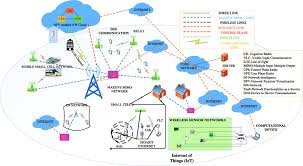Windowed OFDM: Technology, Advantages, and Real-World Applications
telcomatraining.com – Windowed Orthogonal Frequency Division Multiplexing (OFDM) is an advanced communication technology that has emerged as a solution to many challenges in modern wireless systems. It combines the benefits of traditional OFDM with windowing techniques to optimize performance and reduce interference. This article explores the key components of Windowed OFDM, its advantages, and its real-world applications.
What is Windowed OFDM?
Orthogonal Frequency Division Multiplexing (OFDM) is a technique used to transmit data over multiple carrier frequencies, allowing for efficient use of the radio spectrum. It divides the available bandwidth into several narrow subcarriers, each carrying a portion of the data stream. OFDM is particularly effective in combating the effects of multipath fading and interference, making it a popular choice for wireless communication systems.
Windowed OFDM is a variation of OFDM that incorporates a windowing function to reduce side-lobe interference and improve the spectral efficiency of the system. By applying a window function to the transmitted signal, Windowed OFDM minimizes the impact of spectral leakage and enhances signal quality, particularly in environments with high interference or noise.
How Does Windowed OFDM Work?
In a standard OFDM system, the transmitted signal is generated by taking a set of data symbols and modulating them onto subcarriers. These subcarriers are orthogonal to each other, meaning they do not interfere with one another, ensuring efficient data transmission.
Windowed OFDM, on the other hand, introduces a windowing function to the signal before transmission. The window function smooths the signal, reducing abrupt transitions that can cause spectral leakage. This leads to less interference between adjacent subcarriers, improving the signal-to-noise ratio (SNR) and overall system performance.
Key Advantages of Windowed OFDM
- Improved Spectral Efficiency: One of the primary advantages of Windowed OFDM is its ability to improve spectral efficiency. By reducing side-lobe interference, Windowed OFDM allows for better utilization of the available bandwidth, enabling higher data rates without increasing the overall bandwidth.
- Reduced Interference: The windowing function applied to the transmitted signal minimizes spectral leakage, reducing the potential for interference between adjacent subcarriers. This makes Windowed OFDM more robust in environments with high interference or noise, such as urban areas with dense wireless networks.
- Enhanced Signal Quality: The application of a windowing function improves the signal quality by reducing distortions and enhancing the signal-to-noise ratio (SNR). This leads to better reliability and stability in wireless communication systems.
- Flexibility in Deployment: Windowed OFDM is highly flexible and can be implemented in various communication systems, from short-range wireless networks to long-range communication systems. This versatility makes it a valuable technology for a wide range of applications.
Real-World Applications of Windowed OFDM
Windowed OFDM has a broad spectrum of real-world applications, particularly in modern wireless communication systems. Some of the key areas where this technology is being utilized include:
- 5G and Beyond: As the demand for higher data rates and low-latency communication increases, Windowed OFDM is playing a critical role in 5G networks. The technology helps enhance spectral efficiency and reduce interference, ensuring smooth and reliable connections for mobile devices, IoT devices, and other wireless services.
- Wi-Fi Networks: Windowed OFDM is also being employed in advanced Wi-Fi systems, such as Wi-Fi 6 and Wi-Fi 6E. By improving spectral efficiency and reducing interference, Windowed OFDM enables higher throughput and better performance in crowded environments, such as offices, homes, and public spaces.
- Broadcasting Systems: In digital television and radio broadcasting, Windowed OFDM is used to improve signal quality and reduce interference. This ensures a more reliable reception of signals, even in areas with high interference, leading to better quality broadcasts for end-users.
- Satellite Communications: Satellite communication systems benefit from Windowed OFDM, particularly in mitigating interference caused by the vast distances and atmospheric conditions that affect satellite signals. This results in more stable and reliable communication links.
- Wireless Sensor Networks (WSNs): In IoT and wireless sensor networks, where multiple devices need to communicate simultaneously, Windowed OFDM provides an efficient method for managing the available spectrum and reducing cross-interference between devices, ensuring seamless communication.
Conclusion
Windowed OFDM is an innovative technology that enhances the performance of traditional OFDM by reducing interference and improving spectral efficiency. With its ability to handle high levels of interference and provide better signal quality, it is increasingly becoming a crucial component of next-generation wireless communication systems. From 5G networks to satellite communications, the applications of Windowed OFDM are vast and varied, and its potential to drive improvements in communication technologies is immense.







